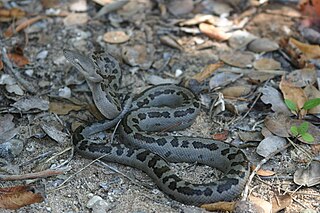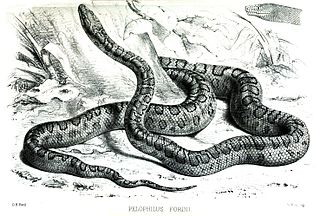
Chilabothrus exsul is a nonvenomous boa species found in the Bahamas. No subspecies are currently recognized.

The Jamaican boa or yellow snake is a non-venomous boa species endemic to Jamaica. No subspecies are currently recognized.

The Puerto Rican boa is a large species of boa endemic to Puerto Rico. It is a terrestrial snake with a dark brown coloration. It grows to 1.9 m (6.2 ft) in length. It feeds on small mammals such as rodents and bats, birds and sometimes anole lizards. Like all boas, it is viviparous and kills its prey using constriction.

Pelvic spurs are the externally visible portion of the vestigial remnants of legs found on each side of the cloaca in primitive snakes, such as boas and pythons. The remnants of a pelvis and femur, which have no connection with the spine, simply "float" in the muscle mass. The femur protrudes from the snake's body and is covered by a horny structure, which resembles a spur or claw. Males' spurs are generally longer and more pointed than females', and are used for clasping and tickling during courtship and mating, as well as combat with other males in some species.
Conception Island is an islet located in the Bahamas. It is 7–9 km2 (2.7–3.5 sq mi) and reaches 25 m (82 ft) above sea level. It is an important rookery for nesting seabirds and hatching site for green turtles. It is uninhabited and protected as part of the Conception Island National Park.

Chilabothrus angulifer, also known commonly as the Cuban boa and the Cuban tree boa by locals as maja de Santa María, is a species of snake if the family Boidae. The species is native to Cuba and some nearby islands. There are no subspecies that are recognized as being valid.

Chilabothrus, commonly known as the Greater Antillean boas or West Indian boas, is a genus of nonvenomous snakes in the subfamily Boinae of the family Boidae. The genus is endemic to the West Indies. 14 species are recognized as being valid.

Chilabothrus chrysogaster, commonly known as the Turks Islands boa or the Southern Bahamas boa, is a species of snake found in the Southern Bahamas and the Turks and Caicos Islands. Local names include rainbow boa, Bahamas cat boa, rainbow snake, and fowl snake. Like all boids, it is not a venomous species.

Chilabothrus monensis, also called the Virgin Islands tree boa in the Virgin Islands, and possibly sometimes as the Mona Island boa elsewhere, is a species of snake in the family Boidae. It is native to the West Indies.

Chilabothrus fordii, known commonly as Ford's boa or the Haitian ground boa, is a species of snake in the family Boidae.

Chilabothrus gracilis is a species of nonvenomous snake in the Boidae family. It is endemic to Hispaniola.

Chilabothrus striatus, the Hispaniolan boa, is a species of snake in the family Boidae. The species is endemic to Hispaniola. The species is regularly found in the international pet trade.
Albert Schwartz was an American zoologist who worked extensively with the herpetofauna of Florida and the West Indies, and later with butterflies. One magazine article once dubbed him as one of the "Kings of West Indian Anole Taxonomy".
The Conception Bank silver boa, Conception Bank boa, or silver boa is a species of boa described in May 2016 by a team of researchers from Harvard University. It is only known from the Conception Island Bank in the Bahamas. It is the first known discovery of a West Indian boa species in 73 years. It is named for its unique silver color and the fact that the first specimen was found in a silver palm.

The Booidea, also known as booid snakes, are a superfamily of snakes that contains boas and other closely related boa-like snakes. As of 2017, Booidea contains 61 species, including the eponymous Neotropical Boa constrictor, anacondas, and smaller tree and rainbow boas as well as several genera of booid snakes from various locations around the world: Candoia from New Guinea and Melanesia, sand boas (Eryx) from northeast Africa, the Middle East, and southwestern Asia, Charina and Lichanura from North America, Ungaliophis and Exiliboa from Central America, Acrantophis and Sanzinia from Madagascar, and Calabaria from tropical west-central Africa.
Chilabothrus schwartzi, also known as the Crooked-Aklins boa or Crooked Acklins boa, is a species of snake. It is endemic to the southern Bahamas, specifically to Crooked Island and Acklins. It was originally described as subspecies of Epicrates chrysogaster, but it was elevated to full species status in 2018. In fact, molecular data suggest a closer relationship with Chilabothrus argentum than with Chilabothrus chrysogaster.
Chilabothrus granti the Virgin Islands boa, is a species of snake in the family Boidae. The species is found in Puerto Rico, the British Virgin Islands, and the US Virgin Islands.

Chilabothrus strigilatus the Bahamian boa, is a species of snake in the family Boidae. The species is found in the Bahamas.











